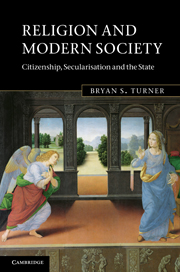Book contents
- Frontmatter
- Contents
- Acknowledgements
- Introduction: the state of the sociology of religion
- Part I Theoretical frameworks: the problem of religion in sociology
- 1 Religion, religions and the body
- 2 Émile Durkheim and the classification of religion
- 3 Max Weber and comparative religion
- 4 Talcott Parsons and the expressive revolution
- 5 Mary Douglas and Modern Primitives
- 6 Pierre Bourdieu and religious practice
- Part II Religion, state and post-secularity
- References
- Index
1 - Religion, religions and the body
Published online by Cambridge University Press: 05 June 2012
- Frontmatter
- Contents
- Acknowledgements
- Introduction: the state of the sociology of religion
- Part I Theoretical frameworks: the problem of religion in sociology
- 1 Religion, religions and the body
- 2 Émile Durkheim and the classification of religion
- 3 Max Weber and comparative religion
- 4 Talcott Parsons and the expressive revolution
- 5 Mary Douglas and Modern Primitives
- 6 Pierre Bourdieu and religious practice
- Part II Religion, state and post-secularity
- References
- Index
Summary
Introduction: etymological roots
The definition of religion has for a long time confounded the sociology of religion. The basic issue is common to sociology as a whole and it concerns the problem of the cultural specificity of our basic concepts. Our understanding of religion may have only small relevance to other societies. In part because Christianity was in the nineteenth century associated, rightly or wrongly, with Western colonialism, there is the suspicion that the definition of religion in the social sciences will be heavily coloured by Christian assumptions. This issue comes out very clearly in Max Weber's comparative sociology of religion, in which, for example, it is not clear that Confucianism is a religion at all. Belief in a High God is largely absent from Asian religious cultures and Confucianism is perhaps best regarded as a state ideology relating to social order and respect for authority. Similarly, Buddhism may be understood as ‘the Righteous Way’ (Dharma) that develops meditation practices to regulate human passions. Daoism is typically a system of beliefs and practices promoting health and longevity through exercises such as breathing techniques. Syncretism is also a notable characteristic of China, especially between Buddhism and Daoism, and hence these religious traditions often overlap and borrow from each other. There was also a cultural division of functions in which Confucianism was important in family concerns, Buddhism for funeral services and Daoism for psychological and health matters.
- Type
- Chapter
- Information
- Religion and Modern SocietyCitizenship, Secularisation and the State, pp. 3 - 29Publisher: Cambridge University PressPrint publication year: 2011



